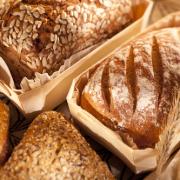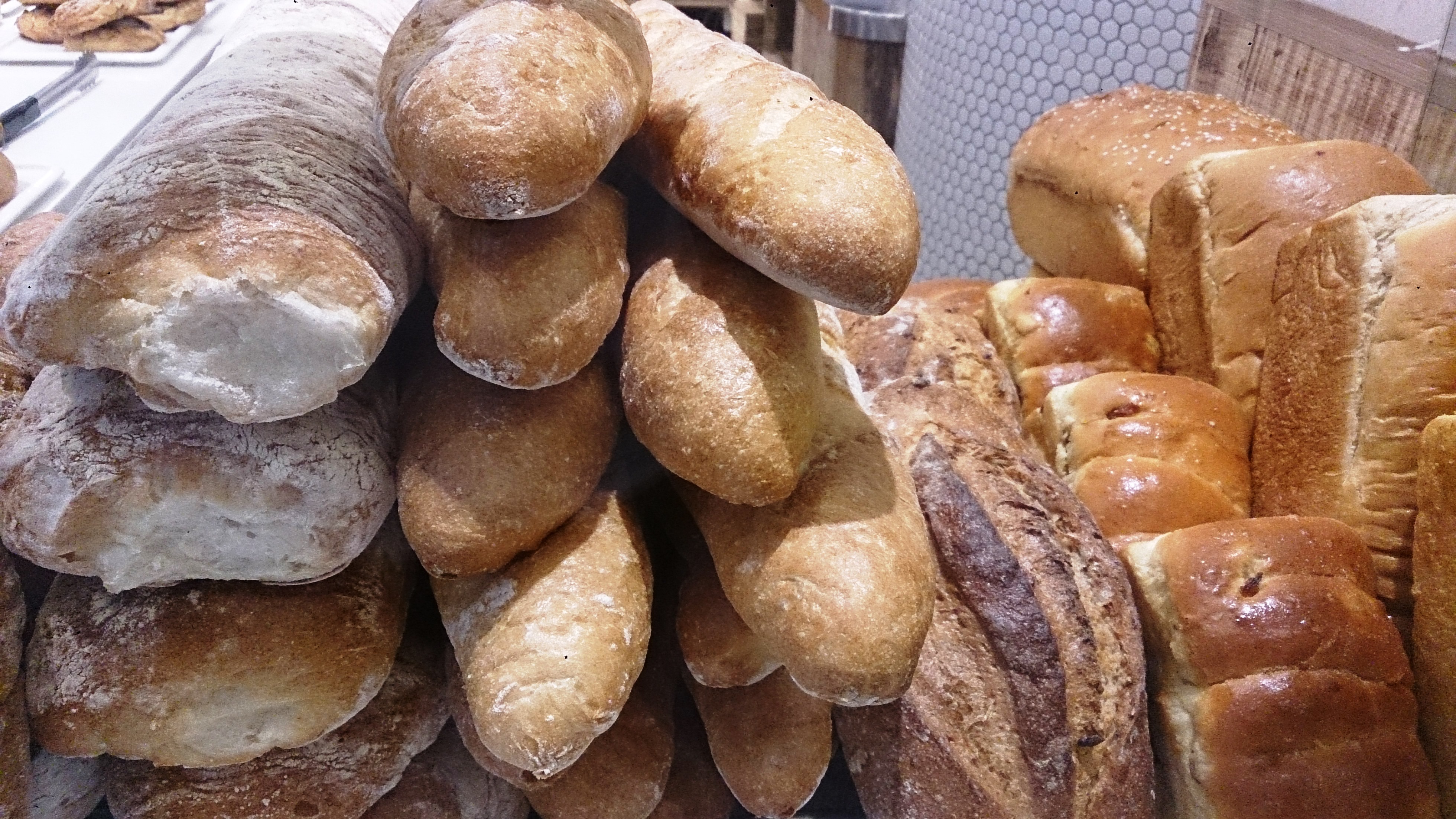Bread Baking Tips and Basic Whole Grain Bread Recipes
Bread Baking Tips!
Whole grain baking, bread and all baked goods, will reconcile you with all those uninspiring bread loaves displayed at your local supermarket or commercial bakery. I am sharing my secrets and bread baking tips for the best and healthiest homemade bread loaf. Whole Grain Baking: Ain’t nothing like it! You will love my streamlined basic recipe.
I use spelt flour for all my baked goods
Except the gluten-free ones. And since I only do whole grain baking, both sweet and savory, let me start with a word about spelt:
While I see no reason to put the whole nation on a gluten-free diet (you will see throughout my latest cookbook that I make ample prevision for our gluten-free friends and offer gluten-free adaptations of countless dishes), I find that the idea of lowering gluten in our diet makes us not only explore the whole gamut of good grains but optimizes our nutrition: My tagline is:
Enjoy spelt:
Less gluten, more protein, more fiber, delicious flavor. I use 100% whole grain spelt, and get fabulous results in all my whole grain baking: breads, cookies, cakes, pies, everything! If you prefer a lighter color bread loaf, use whole white spelt. White does not mean the flour has been bleached, Heaven Forbid! It only means it has been sifted and that the dark chaff stayed behind.
Basic Whole Grain Bread
Consider this the mother recipe. You will be amazed at how many variations on this recipe you can make. Multiply the dough and play with it! My son Yakov can’t live without this bread: Growing up at home, a loaf a day was the very least he was satisfied with. “This bread rules, this bread rocks,” he would always say with delight. He used to tell me, “If everyone would have as much of your bread as I did, and you would market it, you would be a millionaire.” Still, I wouldn’t charge him!
Bread Baking Tips!
You will welcome these simple tips for successful bread baking and all whole grain baking:
- Watch the temp! Hot and cold temperatures and drafts kill the action of yeast and inhibit the rising of the dough, so make sure the water you mix with the yeast is warm, and let the dough rise covered in a draft-free area.
- Not too much salt, please! Remember you are going to eat this bread with other foods, which are often salty, such as cheese, lox, and various spreads.
- RESIST adding flour! When making bread, do not be tempted to add more flour as you go: that’s what makes bread heavy. The gluten in the flour expands during both the kneading and the rising process and absorbs the liquids in the recipe, eliminating stickiness and yielding a light and malleable dough.
- Check for doneness. A well-baked bread will sound hollow when tapped on its bottom.
- Flip the loaves! As soon as you take the loaves out of the oven, turn them upside down to cool to avoid having moisture condense on the bottom crust, making it soggy.
- Wrap the loaves! Wrap the cooled loaves tightly in plastic wrap. If you are not serving the bread on the day you are making it, freeze the wrapped loaves.
- Get a large jar of yeast! Rather than get those pesky, hard-to-open individual yeast envelopes, get a jar at health food stores.
Ingredients
- 1½ tablespoons active dry yeast
- ½ cup warm water
- 1 tablespoon sugar
- 4 ½ cups flour: all-purpose, whole wheat pastry, or spelt, a little (not too much) more if needed
- 1¼ teaspoons salt
- 1 cup warm water
- 2 tablespoons olive oil
Instructions
Mix the yeast, ½ cup water, and the sugar in a big bowl. Let the mixture sit for about 5 minutes: It will bubble (this step is called “proofing”).
Add the flour, salt, 1 cup of warm water, and the oil. Mix by hand until just combined. Turn the mixture onto a lightly floured flat working surface and knead for 10 minutes, turning the dough a quarter of a turn every 2 to 3 minutes and punching it down often to eliminate any air pocket (or transfer the mixture to the bowl of an electric dough maker and set for 5 minutes of kneading). Transfer the kneaded dough into a large mixing bowl (remember, the dough will expand). Sprinkle the dough very lightly an all sides with flour, and cover it with a clean towel.
Let the dough rise in a warm, draft-free area for 2 hours.
It will have about doubled in size.
Play with your bread shapes!
Here are just some examples of my favorites!
Shape the bread into 2 long thin loaves (or 3 or 4 skinny loaves)
If you like your bread to have less crust and more crumb, shape the dough into 2 medium loaves. Or into two two flat round loaves (this is the way we most often make it in Morocco)

If you want a loaf with no crust and all crumb (like a Pullman loaf), place the dough in 2 lightly greased loaf pans.
Place the loaves on a foil- or wax-paper-covered cookie sheet, about 2 inches apart. Slash each loaf on the diagonal in several places with a very sharp knife. Bake in a preheated 400°F oven for about 40 minutes, a little longer for larger loaves.
Whole grain baking bread:
So many possibilities!
Oat bread: Substitute ¾ cup rolled oats for ¾ cup flour in every four cups of flour (in other words: 3¼ cups flour plus ¾ cup oats instead of 4 cups flour). You can also substitute semolina, fine cornmeal, or buckwheat flour in the same proportions as the oats. Bake as for basic bread.
Herb-and-cheese bread: Add to the dough 1 cup plain yogurt, ½ cup chopped dill, and 1 cup grated cheddar. Knead all additions into the dough before letting it rise. Proceed as for basic bread. Makes 2 round loaves.
Caraway or poppy seed bread: Knead ¼ cup caraway or poppy seeds thoroughly into the dough before you let it rise. Bake as for basic white bread.
Moroccan Bread (Khobz): knead 3 tablespoons anise seeds and 1/3 cup sesame seeds into the dough before you let it rise. Shape flat round loaves, and prick all over with a fork.
Walnut raisin bread: Add to the dough: ¾ cup dark raisins, ½ cup chopped walnuts, and 2 tablespoons dark molasses. Knead all three additions into the dough before letting it rise. Shape into 2 loaves. Bake as for basic white bread.
Zaatar bread: Roll the risen dough about ½ inch thin into a rectangle or round, brush lightly with olive oil, and sprinkle generously with zaatar (a delicious Israeli mixture of sesame seeds, oregano, and sumac). Bake only for 15 to 20 minutes. Do not let the dough get crisp, or it will harden.
Focaccia: Roll the risen dough about 1 inch thick, oblong or round. Poke it all over with a finger. Brush with olive oil, and if desired choose one or two of the following toppings, just a light smear: crushed tomatoes, oregano, ground pepper, finely chopped onion, grated cheese, and chopped fresh herbs (thyme, rosemary, sage, etc.). Bake in a preheated 350°F oven for about 40 minutes.
Water challah: If eggless challah is what you prefer, as I do, make the basic bread dough and braid it.
Egg Challah: add 2 eggs and 1/4 cup honey or sugar, and proceed with the basic recipe as above, braiding your challah the usual way. Brush the finished loaf lightly with a mixture of egg and water, and sprinkle with sesame or poppy seeds, if desired. Good word of advice about braiding the bread. Do not stretch the ropes beyond their natural movement, or they will promptly return to their original "unstretched" shape, and tear.





Hi Levana,
My problem is that when I bake bread with whole grains my bread tastes very heavy. Is there any way to avoid this and still use mostly whole grains? Thanks
I can tell you a. don’t have my latest cookbook, http://www.amazon.com/Whole-Foods-Kosher-Kitchen-Glorious/dp/1616082925, and b. You don’t check my search box. Here you go: enjoy! https://levanacooks.com/secrets-of-good-whole-grain-baking-with-recipes/
Rachel so nice to hear from you. Well I was wondering the exact same thing about you. Is it possible you haven’t heard my book was published? And since you took such a special interest, I should tell you it includes a gluten-free index with more than 200 recipes, and a total of more than 350 recipes, all 100% natural!
No trip in the cards. For me this year, loads of stuff going on. Try and call me or email me, we will chat! Love
Thanks, Levana, how have you been? We didn’t exchange “shana tova!” and it’s never , never too late, not at least until chanuka :) bsorot tovot (that means also we should expect to see you again in Jerusalem this year : B”H